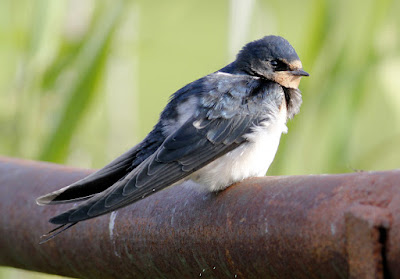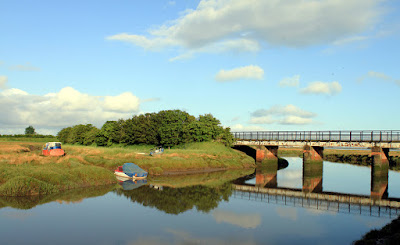There wasn’t much doing at Fluke Hall. A flock of 25+ Linnets indicated at least some partial local breeding success, the group being near enough the most I’ve seen all year. The woodland seemed devoid of anything out of the ordinary with just Blackbirds, Wrens, Tree Sparrows, Goldfinches, and the usual mix of Blue and Great Tit. No warblers again and this is a very strange and apparently unproductive year for many of our “little brown jobs”.
Although there was a stiff breeze from the North West I decided to walk the sea wall so as to check the ditches, the shore and a couple of other spots which occasionally produce a bird or two. Two Whimbrel were feeding along the shore but quickly departed south with their customary rippling whistles when they spotted yours truly coming along. Near the end of the 19th century hunting on the Whimbrel migration routes took a heavy toll on numbers and although the population has since recovered, they retain their fear of man.
These migrant Whimbrels are done with breeding now and heading back to the coast of Africa where they spend the winter.
These migrant Whimbrels are done with breeding now and heading back to the coast of Africa where they spend the winter.
Whimbrel
There was a Green Sandpiper along the ditch plus a couple of Little Egrets and just 2 Lapwings on a muddy stretch.
Driving past Gulf Lane I spotted a distant Buzzard on a fence post but the road too busy to stop. When I pulled into the gateway at Braides Farm there was another Buzzard on a yet another distant post. Buzzards live in a nearby wood where the farmer doesn’t mind me taking a look occasionally as long as I don’t damage his fences. A young Buzzard was calling for food from high in the trees as the adults circled above and protested about me being around. I took a few shots and departed the trees before heading for the stillness of a Glasson Dock morning.
Buzzard
Buzzard
Three Tufted Ducks have made it back to the deep waters of Glasson. They are young birds, their appearance a sign of more tufties to follow in the months ahead when their numbers build to 40 or 50 or maybe 70 or 80 in a colder but unfreezing winter when they can dive for food. A handful of Coots, a few Moorhen and a family party of 9 Mute Swans completed the waterbirds.
Glasson Dock
Tufted Duck
Three Pied Wagtails commuted between the bowling green and the towpath while across the water a lone Grey Heron stalked along the old jetty as it watched the water below for signs of a meal.
Swifts have mainly departed these shores and it’s just ones and twos I see now especially here at Glasson which has tall old buildings where Swifts can enter. A handful of Swallows lined the rails of the lock gates but I think and hope that the adults are on with a second brood on the ledges below.
Grey Heron
juvenile Swallow
A walk along the canal towpath produced little more than a solitary Blackcap, a Song Thrush, and several Tree Sparrows. But my birding pass had expired with not even enough time for Conder Green.
Not to worry, there’s always tomorrow or another day on Another Bird Blog.
Linking today to Weekend Reflections and Theresa's Run A Round Ranch .
























































.jpeg)










.jpg)












